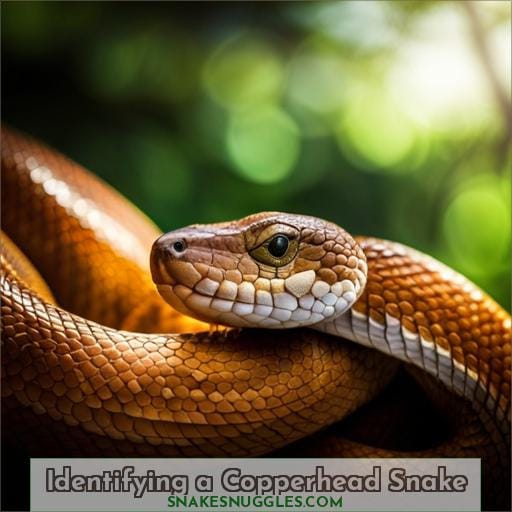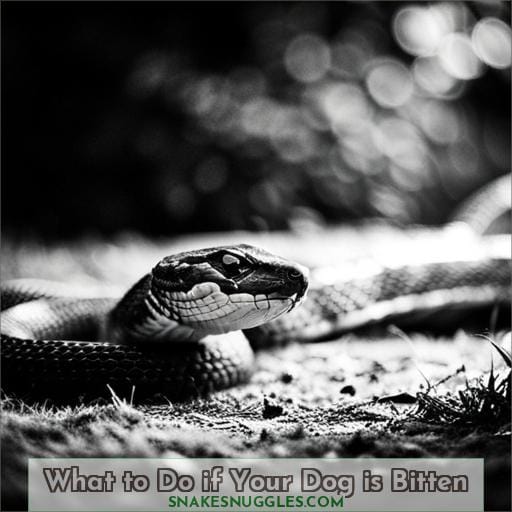This site is supported by our readers. We may earn a commission, at no cost to you, if you purchase through links.

While they’re not typically aggressive, if your dog provokes one, you need to be prepared to provide immediate first aid and seek veterinary attention as soon as possible.
In this article, you’ll find out:
- How to identify a copperhead snake
- What to do if your dog is bitten
- How to recognize the symptoms of a snake bite
- How to prevent future bites
Table Of Contents
- Key Takeaways
- Identifying a Copperhead Snake
- Be Prepared for a Snake Bite
- What to Do if Your Dog is Bitten
- Recognizing Snake Bite Symptoms
- Assessing Bite Severity
- Treating the Snake Bite
- Recovery Timeline
- Preventing Future Snake Bites
- Copperhead Bite Facts
- Frequently Asked Questions (FAQs)
- What should I do if my dog eats a dead copperhead snake?
- How likely is permanent damage or disability from a copperhead bite?
- Do copperheads live in my area? How can I find out?
- Can my other pets also be bitten by a copperhead? What precautions should I take?
- What’s the average cost of treating a copperhead bite with and without antivenom?
- Conclusion
Key Takeaways
- Identify copperhead snake habitats to avoid areas likely to have snakes.
- Prepare an emergency response plan ahead of time, including locating the nearest vet hospital and verifying payment/insurance.
- Recognize snakebite symptoms immediately – swelling, bleeding marks, facial swelling, breathing issues.
- Prevent future bites through vigilance on walks, securing yards, keeping dogs on leashes in snake areas.
Identifying a Copperhead Snake
How do you spot a copperhead before your dog gets too close?
Look for snakes with hourglass patterns down their bodies and triangle-shaped heads.
Copperheads thrive in wooded and rocky areas where leaves accumulate, so be extra vigilant when walking your dog off-trail.
Their camouflage allows them to blend into leaf litter seamlessly until startled.
If you spot a copperhead, give it a wide berth since an upset snake is more likely to strike in self-defense.
Understanding copperhead habitat and markings better equips you to keep your pup safe on adventures.
Delayed reactions could prove dire, so familiarize yourself with proper first aid ahead of time in case the worst still occurs.
Knowing specific symptoms helps assess next steps so you can get your dog swift veterinary care.
Be Prepared for a Snake Bite
You’ll want to identify the nearest emergency veterinary hospital ahead of time so you don’t waste precious minutes looking for help if your dog gets bit.
Have the address and phone number saved in your contacts.
Know their hours of operation, including weekends and holidays.
Verify if they stock antivenom or can treat snake bites.
Confirm they accept your pet insurance or have a payment plan.
Being prepared allows you to focus on your dog and his needs in that critical window just after a bite, rather than scrambling to find a facility that can help. Those first minutes make all the difference between life and death for pets facing venomous snake bites.
Read up on snake safety, know what to look for in venomous species, and map out emergency contacts now before trouble strikes.
What to Do if Your Dog is Bitten
If your dog gets bit by a copperhead:
- Remain calm and keep your dog as still as possible.
- Carefully transport your dog to the vet or emergency animal hospital right away for medical treatment.
- Time is critical, so call ahead to the vet to let them know you’re on the way with a snake bite victim.
First Aid
Upon your dog being bitten, remain calm and immediately carry them to the car to get to a veterinarian right away.
Do not try to treat the bite yourself.
Simply keep them calm, restrict movement, and get professional veterinary help as soon as possible.
Recognizing symptoms like swelling, drooling, weakness early on and seeking emergency care quickly are crucial to your dog’s chances of making a full recovery.
Once at the vet, treatment may include sedation, wound cleaning, antibiotics, and pain control.
Getting Help
Once you’ve administered first aid, speed your dog to the nearest veterinary hospital for immediate attention and antivenin.
- Have emergency contacts for local vets that treat snake bites.
- Confirm antivenin availability and vet availability.
- Understand first aid measures to slow venom spread.
Snake-proof your yard by eliminating hiding spots.
Recognizing Snake Bite Symptoms
Pay close attention to your dog after potential copperhead bites.
Look for:
- Immediate swelling
- Bleeding
- Fang marks at the wound site
- Rapid facial swelling
- Trouble breathing
Recognizing symptoms quickly allows you to seek prompt veterinary care, which is crucial for your dog’s survival and recovery from the bite.
Early recognition saves lives.
Your early recognition of swelling, bleeding, or abnormal behavior saves your dog’s life by allowing immediate veterinary intervention after a copperhead bite.
Recognize puncture wounds and localized pain, swelling, redness, or bleeding at the bite site.
Rapid swelling of the face, eyes, or nose can obstruct breathing.
Drooling, vomiting, diarrhea, or collapse warrants an emergency veterinary visit even without visible bite marks.
The quicker you get help, the better the outcome, as early intervention enables bite severity assessment, appropriate treatment, and monitoring of recovery duration.
Educate yourself on preventive measures regarding copperhead snakes, venomous snakes, anti-venom, and early recognition of envenomation.
Immediate veterinary care crucial.
You’ll need to get your dog to the vet right away if you notice any symptoms of a snake bite:
- Swelling
- Bleeding
- Fang marks at the wound site
Rapid vet attention can make all the difference, so have an emergency plan in place.
Know your closest animal hospital that stocks antivenom and can treat snake bites.
Timeliness is key – the faster you can get treatment, the better the outcome.
Severity often depends on the location of the bite, so be alert.
With proper preparation and fast action, you can help your dog survive a venomous snake bite.
Severity depends on location
The location of the bite will dictate how severe your dog’s symptoms are:
- Bites to the face or neck can obstruct breathing from swelling.
- Bites to the limbs primarily cause localized pain and swelling.
A bite’s severity depends on:
- Location on the dog’s body
- Size of the dog
- Amount of venom injected
- Health of the dog
Early recognition of symptoms and immediate veterinary care are crucial, as the location impacts severity.
Monitoring your dog closely can aid the recovery timeline.
Assessing Bite Severity
Severity assessment depends on bite location and your dog’s reactions:
- Rapid swelling near the head or trouble breathing signal high severity.
Assess the bite right away, examining the wound for fang marks and noting any immediate swelling or bleeding.
- Rapidly spreading edema, especially on the face or neck, indicates a need for urgent care to maintain airway patency.
Other high severity signs are:
- Bleeding that won’t clot
- Seizure
- Collapse
- Paralysis
The quicker these manifest after a bite event, the more rapidly venom is circulating.
Regardless of apparent severity, rush your dog to the nearest veterinary hospital able to administer antivenin.
Their assessment of:
- Wound characteristics
- Symptoms progression
- Bloodwork
- Overall health
Will guide bite severity grading, treatment decisions, and recovery prognosis.
Regular re-evaluation tracks improvement or worsening.
copperhead snake bite, dog, symptoms, prevention, antivenin
Treating the Snake Bite
Once at the vet, your dog will likely be given:
- Antibiotics
- Pain medication
- Possibly antivenom depending on bite severity.
Aftercare is crucial – follow all instructions for:
- Medications
- Wound care
- Activity restriction
- Post-bite monitoring.
Stay in close contact with your vet during recovery to ensure your dog heals properly from the copperhead bite.
At the Vet
When you bring your dog to the vet for a copperhead bite, they’ll first assess the severity through blood work and a physical exam before determining the necessary treatment.
The vet will likely:
- Administer IV fluids and medications.
- Clean and dress the wound.
- Provide pain management.
- Monitor vital signs.
The vet will determine if antivenom is needed based on symptoms.
Having an emergency plan and knowing your local animal hospital’s capabilities can make all the difference in getting prompt, lifesaving care for your beloved pet.
Aftercare
After your vet administers antivenom and provides initial treatment, you’ll need to:
- Care for the bite wound at home while monitoring your dog closely during recovery.
- Keep the wound clean, use antibiotics as prescribed, and limit activity to prevent reopening the wound.
- As the swelling subsides over several weeks, gently stretching and massaging the affected limb can aid rehabilitation.
Though most dogs recover fully with proper care, some suffer long-term damage from the venom.
Continuing check-ups ensure your pup heals smoothly.
Recovery Timeline
You’ll find your dog’s recovery time depends on the location and severity of the bite.
Monitor their healing progress closely over the first few days.
Recovery challenges like infection or tissue damage may lengthen recovery.
Timeframes vary from days to weeks depending on factors like age, health, and bite location.
Employ coping strategies like confinement, medication administration, and wound care to ease their discomfort during recovery.
Continued post-bite veterinary care helps assess their healing and address any lingering effects of the venom.
With proper treatment and attentive at-home care, most dogs fully recover within two to six weeks.
Still, some dogs may deal with longer-term issues like pain or limb dysfunction.
Patience and perseverance through recovery struggles pay off with your dog’s renewed health and vitality.
Preventing Future Snake Bites
Act proactively by keeping your dog on a leash when exploring areas prone to snakes.
Securely fence your yard to minimize your pet’s exposure.
The best defense against snake bites is prevention.
Be vigilant when walking dogs in habitats where snakes may hide.
Make yard boundaries escape-proof.
Invest time into leash training to ensure control on walks.
Educate yourself and family members on snake safety and awareness when outdoors with pets.
Know what kinds of snakes are in your region.
Prepare information on emergency veterinary facilities able to respond to envenomation.
Having phone numbers and after-hours contacts readily available can save critical minutes.
Discuss an emergency snake bite protocol with your veterinarian, including symptoms requiring immediate evaluation.
Advance planning and prevention give your dog the best chance of avoiding snake bites.
Copperhead Bite Facts
According to you, copperhead bites can lead to a variety of concerning symptoms in dogs, ranging from localized swelling and bleeding to systemic problems like low blood pressure and hyperthermia.
When it comes to facts about copperhead bites in dogs, it’s important to remember:
- Copperhead venom rarely causes death in larger animals like dogs, but can be fatal to smaller pets.
- Bites to the face or neck area can obstruct breathing due to swelling around the throat and airway.
- Permanent damage, such as tissue death around the bite area, can occur even with treatment.
Though rarely aggressive, copperheads will bite in self-defense if threatened.
Having an emergency action plan and knowing your nearest veterinary hospitals will ensure you can get your dog rapid medical care should the unfortunate occur.
Stay vigilant when exploring snake territory and always keep your pup leashed.
Frequently Asked Questions (FAQs)
What should I do if my dog eats a dead copperhead snake?
Stay calm.
Immediately take your dog to the vet, regardless of symptoms.
The severity depends on how much venom entered the body.
Do not try home remedies or induce vomiting.
Watch for symptoms like swelling, drooling, or trouble breathing.
Your vet can provide the proper treatment to counteract the venom.
How likely is permanent damage or disability from a copperhead bite?
There is a possibility of permanent damage or disability from a copperhead bite, especially for smaller dogs.
Prompt veterinary care can greatly reduce this risk, but in severe envenomations, permanent tissue damage or impaired function may occur.
Remaining vigilant about copperhead habitats and snakebite first aid steps will better prepare you to handle an incident.
Do copperheads live in my area? How can I find out?
Check with your state’s wildlife agency to see county-level range maps for copperheads.
Search [your state] copperhead range map to locate a map online.
Also, contact local nature centers, parks departments, or university biology departments to learn if copperheads have been spotted in your county recently.
Staying informed on copperhead habitat and recent sightings can help you take precautions if they do live nearby.
Can my other pets also be bitten by a copperhead? What precautions should I take?
Yes, other pets are also at risk of copperhead bites.
Carefully inspect areas before letting them outside.
Keep dogs leashed when possible.
Eliminate snake habitats around your home.
Stay alert on walks and hikes.
With vigilance, you can help protect all your furry friends.
What’s the average cost of treating a copperhead bite with and without antivenom?
Without antivenom, expect to pay $500-$2,
With antivenom, costs jump to $5,000 or more.
Price varies by region, veterinary fees, tests/treatments needed, and dog’s weight.
Discuss costs beforehand so you’re prepared in an emergency.
Always have an emergency fund for pet medical needs.
Conclusion
As the noted herpetologist William G. Kaelin Jr. warns, up to 4,000 dogs succumb to venomous snakebites annually in North America.
[Keypoints]Protect your beloved canine by:
- Learning to identify local venomous snakes
- Avoiding confrontations
- Preparing first aid supplies
Should misfortune strike:
- Remain calm
- Follow proper protocols
- Swiftly convey your dog to emergency care
Though the path ahead may prove arduous, take heart knowing that:
- Diligence
- Modern medicine
- Time’s steady passage
Often allow for full recoveries from even grievous wounds.
With prudence and Providence, you’ll again roam familiar byways together.








